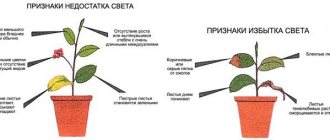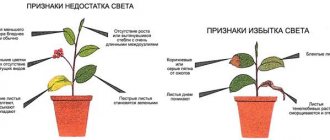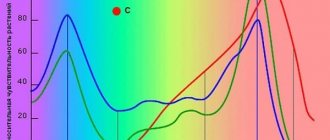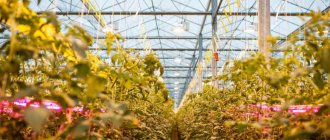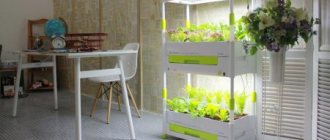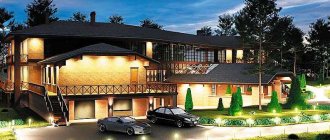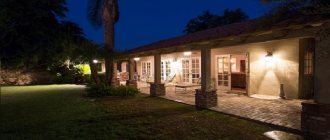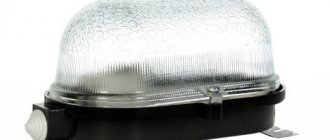Buying a philolamp is not as easy as it might seem at first glance. Manufacturers have done a good job, and the models are presented in a wide variety. Let's figure out which phytolamp to choose and what parameters you should pay attention to.
Those who sow vegetable and flower seeds year after year are well aware of how difficult it is to grow strong seedlings due to the short daylight hours. In low light, photosynthesis processes slow down, seedlings stretch out and grow weak. Therefore, experienced summer residents try to supplement their crops with light.
- How, when and how much to add light to seedlings and is it necessary at all?
Is purchasing specialized phytolamps an important matter or a waste of money?
Alas, an ordinary incandescent lamp is not suitable for this; it does not contain the spectrum of light needed by plants. And it radiates heat in abundance. But a lamp that would perfectly imitate sunlight has not yet been invented.
However, special phytolamps have proven themselves well - they emit light in the range that plants need. Let's talk about them.
At different stages of development, plants require lighting of different spectrums: when seeds germinate, they need a red spectrum, when growing seedlings and growing green mass, more blue, and during flowering and fruiting, a red-orange spectrum.
LED lighting - main characteristics
The advantages of using LED lighting include, first of all, a long service life, no heating during operation, and low electrical energy consumption. In addition, you can create lighting of the required spectrum - for example, using blue and red LEDs.
LED lighting for plants
To create conditions that are natural and favorable for growing, the illumination should be no less than:
- 700 – 1,000 lux – for plants growing in the shade;
- 1,000 - 2,000 lux - for plants that can grow in the shade and prefer diffused light;
- 2,500 lux and more - for light-loving plants.
To calculate a lighting system using LEDs, you need to know the following quantities:
- Illuminated area;
- Installation height of lamps;
- Type of plant (relation to light).
Lighting power is determined in watts per m2. The most useful light waves for plant development are blue and red. Depending on the parameters, light waves have different effects on plants, namely:
| Item no. | Light waves | Wave range, nm | Impact on plants |
| 1 | Ultraviolet | 400 | Promotes resin formation |
| 2 | Infrared | 730 | Helps produce chlorophyll |
| 3 | Blue color | 430 | Helps produce chlorophyll |
| 4 | Red color | 660 | Helps produce chlorophyll |
Blue LEDs
LEDs of this color emit a luminous flux of the blue, blue-violet spectrum, lying in the range from 430 to 490 nm. This light spectrum has a positive effect on plants in the initial growth stage.
Red LEDs
LEDs of this color emit a luminous flux of the red, red-orange spectrum, lying in the range from 600 to 780 nm. This light spectrum has a positive effect on plants at the stage of fruit development and leaf growth.
Full Spectrum LEDs
Phyto LEDs, full spectrum LEDs, are devices that emit an extended range of light waves from a single light source.
Phyto LEDs
Advantages of this type of device:
- The emitted luminous flux is close in characteristics to natural sunlight (range from 400 to 840 nm);
- Suitable for all stages of plant growing;
- Allows you to simultaneously illuminate plants of different development stages.
- The efficiency of use is higher than when using individual LEDs with a narrow spectrum of light emission (1.9 times) and LED assemblies (1.2 times).
Problems for plants with improper lighting
All plants, including indoor plants, vary in their shade tolerance. Many are able to adapt to conditions, for example, to an excess of light or a lack of it. But for some species, ensuring optimal lighting conditions is a vital necessity.
Lack of light
For light-loving species, the optimal length of daylight hours is from 13 to 15 hours. If there is not enough light for plants, their natural development slows down.
What this can lead to:
- thinning of the trunk;
- increasing the distance between leaves;
- deterioration of color brightness, loss of variegated texture;
Plant lacking light
- tilting the plant towards the light source;
Curvature of plants due to lack of light
- insufficient foliage size;
- lethargy, yellowing and falling leaves, especially the lower ones;
- lack of flowering or wilting of buds;
Withering buds
- cessation of growth;
- damage to a weakened flower by pests;
- in the most severe cases - to the death of the plant.
Yellowing of an indoor flower in low light conditions
Excess lighting
An excess of light also leads to disturbances in the development of flowers. They experience severe stress despite adequate watering.
Plants become lethargic, they can get light burn, yellowness appears on the edges of the foliage, affecting individual areas or the entire leaf. Blackening of the leaves is often observed.
The plant begins to deviate from the light source. The lifespan of a flower is significantly reduced. If excessive light is not adjusted, the crop may dry out.
How to determine an excess of light by the appearance of a plant
Types of LED light sources
Currently, a large number of different types of LED lamps (luminaires) are produced, which can be classified as:
- In the form of a pipe - convenient to use when growing plants at home;
- Single spotlight - there are various designs, used for individual use;
- LED panel - used to illuminate a large number of plants, they come in rectangular shape;
- LED strip is universal in use and easy to install. When making LED strips used to illuminate plants, the number of blue LEDs to red ones is 10/3, 15/5, 5/1, respectively. In LED phyto lamps, the proportion of red color is 60-80%, and blue – 40-20%. ;
- LED floodlight is a device for industrial use. It is possible to illuminate large areas from a remote distance.
LEDs are narrowly focused light sources, which determines the conditions for their installation. When installing luminaires, you should consider:
- Plant height;
- Arrangement of plants (distance between them).
Plant seedlings: light and spectrum
Comments 2015.01.30
Many gardeners who have attempted to grow seedlings in their “track record” have faced an unpleasant obstacle to an excellent harvest in the form of “pulling” seedlings (especially important when sowing in the spring in the absence of good lighting).
Let's understand the causes of the problem and find ways to fix it. First, a little theory.
Daylight spectrum
From school, everyone knows that the phrase “Every Hunter Wants to Know Where the Pheasant Sits” provides a list of colors in reverse order (from right to left) into which a ray of light is decomposed when refracted violet 390-440
blue 440—480
blue 480—510
green 510—575
yellow 575—585
orange 585—620
red 630—770
Video about the effect of light spectrum on plant growth.
For color or spectral component, the main characteristic is the wavelength, measured in nanometers. White color is characterized by a wavelength of 400 - 800 nm. In the frequency range, violet is at the bottom (short wavelengths, 400 nm) and red is at the top (long wavelengths, 800 nm). In the first case we are dealing with ultraviolet radiation, in the second with infrared radiation). I would like to note right away that in the case of plants, red color is divided into simply red (660 nm) and far red (730 nm), both of which are important.
A logical question arises: why is daylight white, but the world around us is colored? Why do objects, phenomena, objects have one color or another? The answer is extremely simple: if the particles of an opaque object have the property of reflection, for example, red color and absorption of other colors, then the object will be red. The same is true with other colors.
Photosynthesis
Let's look at the life process of an adult growing green plant. Mandatory conditions for existence are: sun, air and water (as well as mineral nutrition from the soil). Solar energy gives the plant the necessary energy, air (more precisely carbon dioxide, i.e. carbon dioxide) is carbon, the main building material, and water is the oxygen contained in it at the molecular level. As a result of the interaction of these three components during photosynthesis, organic compounds—carbohydrates—are formed with the help of a special pigment, chlorophyll. In daylight, water is divided into oxygen and hydrogen, as well as energy is stored. In the darkness of the night, due to energy reserves, a combination of carbon dioxide and hydrogen is observed, which results in the formation of carbohydrates. An important detail is that all living creatures on earth breathe the oxygen released during the daytime phase of photosynthesis.
Photomorphogenesis
Photomorphogenesis is a set of processes that can be observed in a plant under the influence of lighting, which is characterized by a diverse spectral composition and intensity. In this case, light is not so much a source of energy as a signaling device that regulates the life processes of the plant, in particular, growth and development. This can be compared to the operation of a traffic light at an intersection. Unless the control involves not red-yellow-green, but other colors: blue, red and far red. Take a closer look at the process of seed germination. Waking up in the dark soil, the seed begins to germinate, heading upward towards the sun. It should be noted that even seeds sown superficially and seedlings in general standing in a bright place make a leap in growth exclusively at night, in the dark. That is why you can admire the mass shoots only in the morning. However, taking another look and observing our purposeful sprout striving to the surface, you can notice an interesting feature: it will grow intensively until it receives a sign-signal from nature: “You can slow down, you’re already on the surface, which means you’ll survive.” This notification for him is not air, moisture or seismic vibrations, but a short-term pulse of red radiation (the idea comes to mind that people borrowed the corresponding traffic light signal from nature). Before receiving the light message, the sprout will be in an etiolated state, which is characterized by a pale appearance and a hook-shaped shape. The observed hook is nothing more than an epicotyl or hypocotyl, i.e. a way to protect the bud (growth point), which is needed on its difficult path to the sun. The above described state will persist as long as growth continues in the dark. In order to bring the plant out of this state, daily short-term illumination lasting 5-10 minutes should be carried out.
Red color
Let's take a closer look at the reasons for the described phenomenon. It turns out that in addition to chlorophyll, each plant contains another extremely important pigment—phytochrome, a protein that greatly enhances the plant’s ability to capture light and its spectral shades. A distinctive feature of phytochrome is that it is capable of taking two forms, which are different from each other, and depend on exposure to red light (660 nm) and far-red light (730 nm), respectively. Therefore, alternating exposure to 2 types of red light is equivalent to manipulating an on/off switch.
It is the described features of phytochrome that are responsible for maintaining the “day routine” of plants and controlling the frequency of life cycles. In addition, this pigment is also responsible for the flowering of plants. Well, as the dear reader might have already guessed, the shade tolerance and light-loving nature of plants are also associated with phytochrome.
Now the principle of the phenomenon becomes clear, thanks to which in our sprout, once on the surface and receiving even a short-term amount of illumination, the process of de-etiolation is launched. All this happens thanks to the rays of ordinary red light, of which there are much more in the daytime sunlight than far red light.
An inquisitive amateur gardener will certainly wonder how to distinguish between 2 types of red light? The answer is extremely simple. As everyone knows, red light borders on infrared, i.e. thermal radiation, which means that the “warmer” the light is perceived by the skin, the more far red rays prevail in it. An idea of the described property can be obtained simply by raising your hand to a regular incandescent lamp, and then to a “cooler” fluorescent fluorescent lamp.
blue light
Having clarified the situation with red light, let's dot the i's with the issue of blue light - our pheasant from the given children's rhyme at the beginning of the article, which directly embody the violet-blue part of the spectrum - and find out how it affects the life of plants. It should be noted that the presence or absence of yellow-green color does not in any way affect the development of the plant.
So, blue light is extremely important because it contains another pigment, cryptochrome, which is very sensitive to light in the range of 400-500 nm. In adult plants, blue color is responsible for regulating the width of leaf stomata, for elongating leaves following the sun and suppressing seed germination and stem growth. The last point is very important to prevent “pulling” of seedlings. Another interesting observation related to the suppression of stem growth: on the lighting side, cell growth is inhibited, so the stem becomes curved towards the light source. Perhaps everyone had the opportunity to see the seedlings bent towards the window. Well, this is thanks to blue light. This phenomenon is called phototropism.
The ultraviolet part of the spectrum, which also belongs to the blue color, has the effect of inhibiting the stretching of cells, but accelerating their influence. That is why alpine plants have a low-growing shape, and their “relatives” growing in shady places or under glass, on the contrary, stretch out.
Practical conclusions
Let's try to draw certain conclusions for ourselves that will help us in practice. First of all, we are interested in the conditions of the apartment in early spring and the resulting need for artificial lighting (due to the short daylight hours), which is of great importance due to the many dangers that await us. Obviously, everything is much simpler at a later time in an open space (for example, in a garden), because the sun takes over the role of lighting.
The first question arises: where is the best place to place seedlings? In the dark or in the light?
1) In the light. The advantage is that immediately after germination, the shoot is guaranteed to receive a dose of the necessary red light to exit the etiolated state. Disadvantage: it is possible to observe an inhibitory effect on seed development. 2) In the dark. The advantage is a greater chance of germination, since the possible inhibitory effect of blue and red light is eliminated. The disadvantage is the possible appearance of “elongated” seedlings in the absence of a timely response to the emerging seedlings.
The first option looks more preferable if it is not possible to devote all your free time to seedlings. But the next option will be the best solution. During the day, the seedlings are kept in a dark place, and at night, while the plants are growing, place them on the windowsill near the light. After overnight germination, here comes the morning sun. Then it will be like in the proverb: “And the wolves are fed, and the sheep are safe.” There is another option for everyone: in cloudy weather, shine artificial light on the seedlings for 10 minutes in the morning.
The second important question: what kind of lamp to use. Here, first of all, the spectral characteristics of the device should be taken into account, and the power and other parameters are secondary. Despite the fact that sometimes the information may be somewhat embellished by the manufacturer, the necessary data can be found without problems. Of course, we are not talking about professional equipment here. Conventional incandescent lamps are completely unsuitable because they contain too much infrared and yellow radiation, but very little blue. Against this background, the use of a fluorescent daylight lamp looks much more appropriate due to the sufficient amount of blue light with low exposure to the red gamma spectrum. Of course, it is best to use artificial lighting in the early morning and/or late hours, leaving the plants to enjoy the sunlight from the window during the day.
To summarize everything that has been written, let me adapt the rhyme about a rainbow in a different manner, characteristic of us gardeners. Let, instead of “Every Hunter Wants to Know Where the Pheasant Sits”, there will be “Every Eagle Owl Guess Where the Hares Are Fattest” - when growing plants, red, purple and blue colors are extremely important, while green, yellow and orange have almost no meanings.
Recommended reading
- LED phytolamps against HPS
- Research on increasing the efficiency of fluorescent lamps
- 10 advantages of LED phytolamps
- The whole truth about LED phytolamps
LED Lighting Manufacturers
Currently, the light source market offers a fairly wide range of LED lamps that differ in design, power, type of performance and their manufacturer. The most famous are:
"Komled", Kazan, Russia is a manufacturing company specializing in the production of LED lamps for various purposes. For plant lighting the following are available:
- “Optima F” lamps – power from 38.0 to 220 W and luminous flux from 3036 to 18216 Lm, respectively;
- “Line F” lamps – from 10.0 to 65.0 W and luminous flux from 1331 to 9318 Lm, respectively.
"SVETOTRONIKA", St. Petersburg, Russia - the company produces a wide range of LED lamps of various designs and purposes. For lighting plants, lamps with a power of 50 Watt are produced, with a luminous flux of 79.3 µmol/s lumens and a color temperature of 450 nm - 32% (8 diodes) and 660 nm - 68% (16 diodes):
- SVT-BIO L-50-45;
- SVT-BIO L-50;
- SVT-BIO L-50-20×50;
- SVT-BIO L-50-10×60;
- SVT-BIO L-50-25;
Largest foreign manufacturers:
- Nichia Corporation, Japan;
- Samsung LED, South Korea;
- Osram Opto Semiconductors, Germany;
- LG Innotek, South Korea;
- Seoul Semiconductor, South Korea;
In addition to those listed above, LEDs from lesser-known domestic and foreign manufacturers are also available on the domestic market, so anyone can choose an LED lamp in accordance with the requirements for it.
DIY LED lighting for plants
If you have electrical installation skills, free time and desire, you can make LED lighting yourself, so to make a phyto lamp you will need:
- Fluorescent lamp housing;
- Power supply 220/12 V, you can use a used one;
- LED matrices or LEDs;
- Connecting wires (copper, cross-section not lower than 0.75 mm2);
- Cooling plate (cooler);
- Aluminum strip.
LEDs of selected colors (the colors and their relationships are given above) are attached to the LED matrix or connected in parallel, using connecting wires or soldering, in accordance with the polarity of the devices.
The number of LEDs connected (their total power) must correspond to the power of the power supply. Mounting is carried out on the cooling plate. Also, to cool the LEDs, ventilation holes are made in the lamp body by drilling. In the case of using an LED matrix, the light source is glued to an aluminum strip, which is placed inside the lamp body.
Rules for lighting devices for plants
Plants need to be provided with:
- correct thermal conditions;
- sufficient daylight hours;
- required spectrum of light.
Flowers can be compensated for the lack of sunlight they receive by using artificial lighting.
Additional lighting for indoor flowers
Different types of plants require different levels of light. For most flowers, 2000...5000 lux is enough for normal development. But exotic representatives of the flora need to be provided with from 10 to 50 thousand lux.
Approximate standards of required illumination for various types of indoor flowers are presented in the photo.
Light standards for normal plant development
Particular attention must be paid to creating the right conditions for the development of light-loving flowers:
- lighting intensity within 140...220 W/m2;
- spectral saturation consisting of red and blue colors.
The most important for the life of plants are red rays with a wavelength of 600...720 nm and orange (595...620 nm). They are necessary for the flower to receive energy for photosynthesis.
Blue, having a wavelength of 380...490 nm, is involved in protein formation and regulation of development speed. Ultraviolet rays help synthesize vitamins and prevent stems from stretching. Yellow and green do not play a special role.
Light sources should be placed above the plants. This way you can avoid their bending. It is also important to maintain a distance from the lamp to the flower so as not to cause burns or excessive stretching of the stems.
Lighting located above the plant
